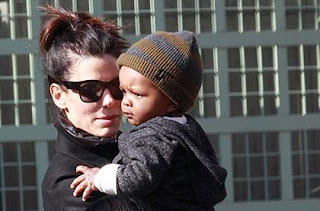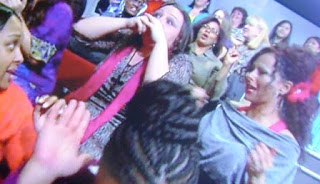Haiti is still recovering from January 12, 2010 - the dark day on which 300,000 people there died in a devastating earthquake. In its wake, with the help of actor Sean Penn, came the HRO or Haitian Relief Organization.
Fast forward to now and you'll find Sean Penn spending a great deal of his time in Haiti. CBS's 'Person to Person' went to Haiti to profile Penn. It aired last Friday and I loved seeing him using compassion & determination to help Haitians rise from the rubble around them.
Sean Penn lives in Haiti "50% of the time" and his Haitian accommodation is described in the interview as a “plywood cubicle” inside a house with 15-20 of his HRO staff.
His room is a *really* small space - as wide as the arm span of Person to Person journalist,
Charlie Rose.
Note the photo ID card hanging on the wall. I'd really like to try it on as I suspect it has magic powers and would automatically grant me access to a time machine set to reliving
Madonna's mid-80s heyday. ;-)
That's Sean Penn is his little Haitian room. I can't even imagine how different it likely is from any other dwelling this well-paid actor has found for himself elsewhere. And is it just me or doesn't that autographed 2012 Pin-up calendar on the wall give his room a certain jail cell quality?
Of living in Haiti he says, "the roosters in Haiti don't wait for dawn and so for me the two most popular things are earplugs and Ambien."
I was aware of Sean Penn's involvement in the rebuilding of Haiti, but I didn't know why he is involved.
The story according to Penn goes something like this: his son Hopper suffered a traumatic brain injury. Fortunately he's doing okay today, but Sean Penn witnessed the pain his son was in, and the relief he felt from a morphine drip. Sean Penn wanted to bring a similar kind of relief to Haiti.
He says “civil war”-style medicine was being practiced following the quake. Here's an example: a patient was given an aspirin and then doctors would proceed with a medically-necessary amputation using with a hardware store hacksaw.
Oy! Those are Penn's words, not mine.
So, he went about creating the Haitian Relief Organization, J/P HRO.
Sean Penn says, "When you look down a city block of devastation and you see the pain of people and the death, you feel like, 'I can fix this'. Then a chopper ride over the devastated area led him to see “it wasn't about fixing it anymore, it was about helping as much as you could.”
And that was part of the beginning for Sean Penn and his relief organization in Haiti.
When asked if his work in Haiti has given him a chance to exercise some muscles he may not have known he has: “It's all lessons of surfing... I know when I'm in the right position to catch a wave, and I know when I'm not. And I knew I was in a place where I could do something.”
He now has the official government title, Ambassador at Large for Haiti. His most visible public task in Haiti is clearing the rubble from Haiti's national palace.
Of the national palace Penn says, "as an outsider certainly it seemed to be a symbol not
only of Haiti's past, but of the devastation, of the fracturedness of
the country. So it was time for Haiti to have a real, new start."
A J/P HRO clinic, as seen above, is a very busy place. There is 10-15 babies a week born here. And every month over 8,000 patients are treated. The healthcare services are all free provided by J/P HRO. Penn's team has also created a school, launched a community centre and hired Haitians to build new homes.
Haiti's only golf course is now a temporary housing camp (seen below) for
displaced earthquake survivors.
Sean Penn tells Charlie Rose that the HRO's main role is camp
management and to advocate on behalf of the camp populations. The camps
once had a population 60,000 people. But a great deal of them have been
relocated and there is now just over 14,000 people there who still need a
permanent home.
Amazing progress, eh? But 14,000 is still a huge
number.
In the camp, Penn and Rose also spoke with this woman who was pulled from the rubble and told the TV crew: “I lost two of my children, a son and a daughter.”
So where does all the money come from to do what J/P HRO does?
Penn says, "I can tell you it's
millions of dollars of my money. It's what I can do. Money is not even
the answer to how to fix this place. Belief in it."
But he says he could be doing more if only there was more donor money.
"Where is the
courageous company with any kind of social responsibility that is going
to serve both the United States interest and the Haitian human interest
by bringing investment to this country, with all its magic
possibilities. Where are these companies? Shame on those who aren't
giving it a go.”
As his work has progressed he says he's
changed too. Sean Penn says Haitians have given him more than he's given
them. “They've given me a real proximity to humility. I know what I have
to do when I wake up in the morning. And I'm never bored.”
The teenage stoner Sean Penn portrayed in the classic 80s movie '
Fast Times at Ridgemont High' is cool, but Sean Penn himself - for all his work in Haiti - is way cooler, don'tcha think?
Go ahead and throw in a comment down below, it'd be nice to know your thoughts about this.
All photos CBS

.jpg)




.jpg)






























































































